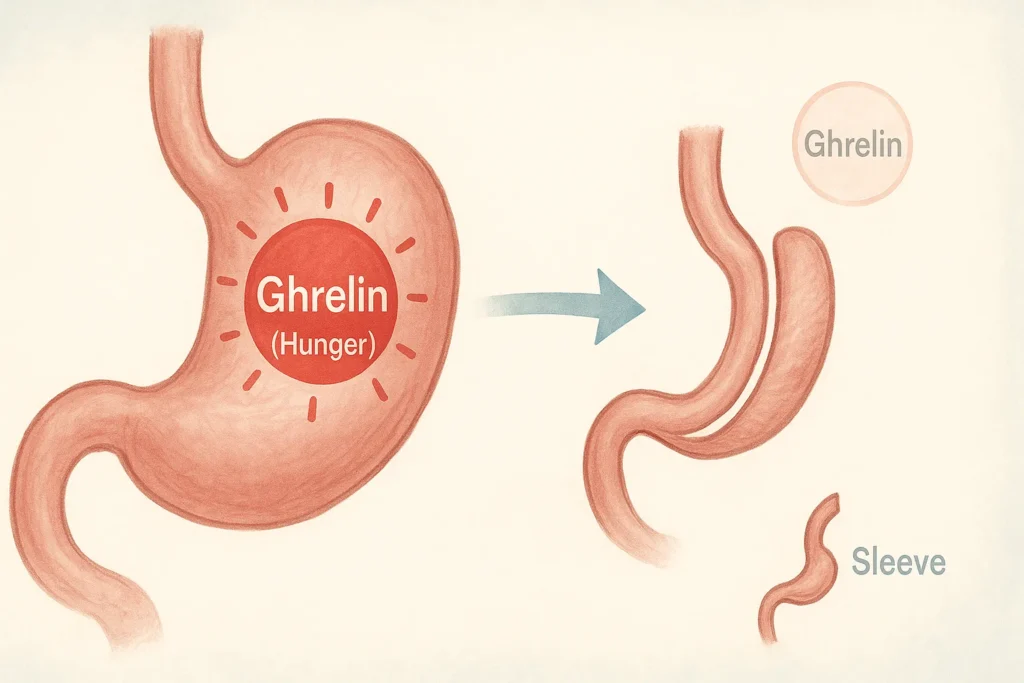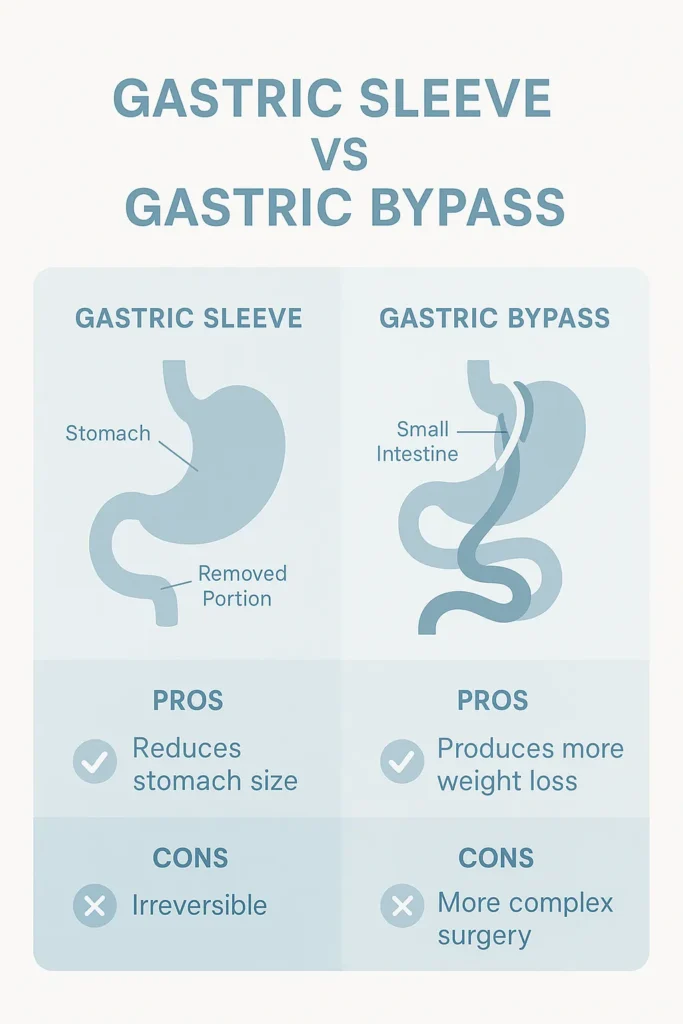מהם 4 סוגי ניתוח בריאטרי? מדריך מלא

The decision to pursue bariatric surgery is a life-changing one, but it’s only the first step. The next, and equally important, question is: which surgery is right for me? When you search for what are the 4 types of bariatric surgery, you are seeking clarity on a complex topic that will have a profound impact on your future health. Understanding the differences, the pros, and the cons of each procedure is essential for making an empowered and confident choice.
At Vivid Clinic in Istanbul, we believe that an educated patient is a successful patient. This comprehensive guide will provide a clear, detailed breakdown of the four main types of weight loss surgery. We will explain exactly how each one works, who it’s best for, and provide honest answers to your most urgent questions about safety, recovery, and what life looks like after the procedure. Our goal is to demystify your options so that, together with our expert surgeons, you can choose the perfect tool for your personal transformation.
The Core Principles: How All Bariatric Surgeries Promote Weight Loss
Before diving into the specific types, it’s important to understand the fundamental ways these procedures work. They are not just about surgically removing fat; they are sophisticated metabolic tools that alter your body’s digestive process and hormonal signals.
- Restriction: This is the most straightforward principle. The surgery reduces the size of your stomach, in some cases by up to 80-90%. A smaller stomach means you feel physically full after eating very small amounts of food, which naturally restricts your calorie intake.
- Malabsorption: Some procedures reroute the small intestine, changing the path that food travels after it leaves the stomach. This means the body has less time and opportunity to absorb calories and nutrients from the food you eat.
- Hormonal Changes: This is a powerful, often overlooked benefit. By altering the stomach and intestines, the surgery has a significant impact on gut hormones. Most notably, it dramatically reduces the production of ghrelin, the primary “hunger hormone.” Patients report feeling significantly less hungry after surgery, making it much easier to adhere to a low-calorie diet.
Each of the four main types of bariatric surgery uses a combination of these principles to achieve its results.

A Deep Dive into the 4 Main Types of Bariatric Surgery
Here, we break down each procedure, explaining how it works, its primary benefits, and its potential downsides.
1. The Gastric Sleeve (Sleeve Gastrectomy)
The Gastric Sleeve has become the most popular weight loss surgery in the world, and for good reason. It is a highly effective procedure with an excellent safety profile.
- How It Works: The Gastric Sleeve is a purely restrictive procedure. The surgeon removes approximately 80% of the stomach laparoscopically (using keyhole incisions). The remaining portion of the stomach is shaped into a narrow, banana-sized tube or “sleeve.” This drastically limits the amount of food you can consume at one time. Crucially, the part of the stomach that is removed is responsible for producing most of the body’s ghrelin, leading to a powerful reduction in hunger.
- Pros:
- Excellent Safety Profile: It is technically a simpler procedure than a gastric bypass.
- No Intestinal Rerouting: This means a lower risk of nutritional deficiencies and complications like “dumping syndrome.”
- Powerful Hunger Reduction: The removal of the ghrelin-producing part of the stomach is a significant advantage.
- Effective: Patients can expect to lose 60-70% of their excess body weight.
- Cons:
- Irreversible: The portion of the stomach is permanently removed.
- Can Worsen Acid Reflux: It is not always the best choice for patients with severe, pre-existing GERD.

2. The Gastric Bypass (Roux-en-Y)
Often considered the “gold standard” of weight loss surgery due to its long history and proven results.
- How It Works: The Gastric Bypass uses both restriction and malabsorption. First, the surgeon creates a very small stomach pouch, about the size of an egg, separating it from the rest of the stomach. Next, the small intestine is divided and rerouted, with the lower part being connected directly to this new pouch. Food now bypasses the majority of the stomach and the first section of the small intestine.
- Pros:
- Highly Effective for Weight Loss: Often produces slightly more and faster weight loss than the sleeve.
- Excellent for Diabetes Remission: The intestinal rerouting has powerful metabolic effects that can resolve Type 2 diabetes in a very high percentage of patients.
- Long-Term Data: Its effectiveness has been studied for decades.
- Cons:
- More Complex Surgery: It is technically more demanding than a sleeve gastrectomy.
- Higher Risk of Nutritional Deficiencies: Lifelong, rigorous adherence to a vitamin and mineral regimen is non-negotiable.
- Risk of Dumping Syndrome: Eating high-sugar foods can cause unpleasant symptoms like nausea, cramping, and diarrhea.
3. The Adjustable Gastric Band (Lap-Band)
This procedure was popular in the early 2000s but is rarely recommended or performed by top surgeons today, including our team at Vivid Clinic.
- How It Works: A silicone band is placed around the top of the stomach, creating a small pouch. The band can be tightened or loosened by injecting saline through a port placed under the skin.
- Why It’s No Longer Favored: While it is reversible and doesn’t involve cutting any organs, the long-term results are poor compared to the sleeve and bypass. It produces less weight loss and has a very high rate of long-term complications, including band slippage, erosion into the stomach, and esophageal dilation, often requiring re-operation and removal. At Vivid Clinic, we prioritize procedures with the best, most durable, and safest long-term outcomes for our patients.
4. The Duodenal Switch (BPD/DS)
This is the most complex and powerful form of bariatric surgery, reserved for a very specific subset of patients.
- How It Works: It combines two surgical steps: a sleeve gastrectomy to reduce stomach size, and a very extensive intestinal bypass that reroutes food away from the majority of the small intestine.
- Pros: It produces the greatest and most durable weight loss, with patients often losing 80-90% or more of their excess body weight.
- Cons: It carries the highest risk of severe, lifelong nutritional deficiencies (especially for fat-soluble vitamins and protein). It also has a higher risk of surgical complications. This procedure is generally reserved only for patients with a very high BMI (typically over 50 or 60).

The Vivid Clinic Experience: Expert Guidance for Your Choice
Understanding your options is the first step. The next is having an expert guide you. Your journey with us is designed to provide this clarity. Upon your arrival in Istanbul, א הסעות VIP משדה התעופה brings you to your מלון 5 כוכבים. The most important part of your pre-operative experience is your ייעוץ אישי with our expert bariatric surgeon. During this meeting, you will discuss your health profile, your goals, and the pros and cons of each procedure as they apply to אַתָה, ensuring you make the best possible choice. On your יום הניתוח, you’re cared for by our elite team. Your טיפול לאחר הניתוח ו ביקור בדיקה are meticulous. Finally, you’ll be ready for יְצִיאָה, supported by our מעקב טיפול מרחוק program.
Bariatric Surgery Procedure Overview
| אַספֶּקט | Details (Typical for Sleeve/Bypass) |
| משך התהליך | 1–2 hours |
| משך האשפוז | 2–3 nights |
| משך הניידות | Walking is encouraged within hours of surgery |
| חזרה לפעילות | 2–4 weeks for desk jobs; 6 weeks for strenuous physical activity |
| החלמה מלאה | 4–6 weeks for physical incision/staple line healing |
| תוצאות צפויות | Peak weight loss achieved at 12–18 months |

שאלות נפוצות (FAQs)
When considering what are the 4 types of bariatric surgery, which one is generally considered the safest for most patients?
While all surgeries have risks, the Gastric Sleeve (Sleeve Gastrectomy) is generally considered to have the highest safety profile among the most effective options. It is a technically simpler procedure than the Gastric Bypass or Duodenal Switch because it does not involve rerouting the intestines, which reduces the risk of long-term nutritional complications.
Of the answers to what are the 4 types of bariatric surgery, why are the Gastric Sleeve and Gastric Bypass the most commonly performed today?
The Gastric Sleeve and Gastric Bypass are the most common because they offer the best balance of safety and effectiveness. They provide excellent, durable weight loss and resolution of obesity-related diseases. In contrast, the Gastric Band has proven to be less effective with more long-term complications, and the Duodenal Switch is typically reserved for extreme cases due to its higher complexity and risk.
I have Type 2 Diabetes; when I ask what are the 4 types of bariatric surgery, which one is typically recommended for me?
For patients with Type 2 Diabetes, the Gastric Bypass is often considered the “gold standard.” The intestinal rerouting in a bypass has powerful metabolic effects that can lead to diabetes remission in up to 80-90% of patients, often very quickly after surgery. While the Gastric Sleeve also significantly improves diabetes, the effects of the bypass are generally more profound.
After learning what are the 4 types of bariatric surgery, what is the next step in determining my personal eligibility?
The next step is a thorough consultation with a qualified bariatric surgeon. After reviewing your medical history, your current health status, your BMI, and any obesity-related conditions you have, the surgeon can help you determine if you are a candidate and which procedure would be the safest and most effective choice for your individual circumstances.
If I want to understand what are the 4 types of bariatric surgery, how does the recovery time differ between the main options like the sleeve and bypass?
The initial recovery timeline for a Gastric Sleeve and a Gastric Bypass is remarkably similar. Both are performed laparoscopically, involve a 2-3 night hospital stay, and a return to most normal activities within 2-4 weeks. The long-term dietary adjustments are slightly more stringent with the bypass due to the risk of dumping syndrome and the greater need for vitamin supplementation.
Conclusion: Making an Informed Choice for Your Future
Now that you understand the answer to what are the 4 types of bariatric surgery, you can see that there is no single “best” procedure—only the procedure that is best for אַתָה. This choice is a critical one, dependent on your unique health profile, your tolerance for risk, and your personal weight loss goals. Making this decision with the guidance of an expert, compassionate surgeon is the key to unlocking a healthier future.
Are you ready to discuss which option is right for you? צרו קשר עם מרפאת Vivid עוד היום for your free, no-obligation יִעוּץ and let our experts help you take the next step.
הפניות וקריאה נוספת
To provide our readers with trusted, third-party information, we’ve compiled a list of resources from leading medical organizations that detail the different types of bariatric surgery.
- American Society for Metabolic and Bariatric Surgery (ASMBS) This page is the definitive resource from the leading surgical society, providing a detailed breakdown of the Gastric Sleeve, Gastric Bypass, Duodenal Switch, and other procedures.
- Johns Hopkins Medicine An excellent overview that not only describes the different procedures but also discusses the advantages and disadvantages of each, helping patients understand the trade-offs.
פוסטים אחרונים מבלוג Vivid Clinic
-
 כיצד שיתוף פעולה בין-מחלקתי משפר את תוצאות הטיפול בחולים
כיצד שיתוף פעולה בין-מחלקתי משפר את תוצאות הטיפול בחולים -
 השוואת עלויות השתלת שיער בארה"ב: מדוע Vivid Clinic מספקת יותר בפחות
השוואת עלויות השתלת שיער בארה"ב: מדוע Vivid Clinic מספקת יותר בפחות -
 אמנות האף היפה: מדריך להשגת המראה המושלם שלך באיסטנבול
אמנות האף היפה: מדריך להשגת המראה המושלם שלך באיסטנבול -
 תופעות לוואי ארוכות טווח של ניתוחים פלסטיים: מדריך מקיף לעתיד גופך
תופעות לוואי ארוכות טווח של ניתוחים פלסטיים: מדריך מקיף לעתיד גופך -
 תופעות לוואי של ניתוח פלסטי בפנים: מדריך מקיף של מומחה לסיכונים והחלמה
תופעות לוואי של ניתוח פלסטי בפנים: מדריך מקיף של מומחה לסיכונים והחלמה -
 השפעות ארוכות טווח על שאיבת שומן: מדריך מקיף למטופל לתוצאות לאורך זמן
השפעות ארוכות טווח על שאיבת שומן: מדריך מקיף למטופל לתוצאות לאורך זמן
הפוסטים הפופולריים ביותר
-
 בחינת סוגים שונים של אף וצורות עבור נשים וגברים
בחינת סוגים שונים של אף וצורות עבור נשים וגברים -
 מדריך מקיף לסוגים שונים של אפים: מיווני ועד נובי
מדריך מקיף לסוגים שונים של אפים: מיווני ועד נובי -
 אף רומי ו-9 צורות אף אחרות מוסברות: מצאי את המראה המושלם שלך עוד היום
אף רומי ו-9 צורות אף אחרות מוסברות: מצאי את המראה המושלם שלך עוד היום -
 השוואת עלויות השתלת שיער עולמית (2025): מדוע טורקיה נשארת #1
השוואת עלויות השתלת שיער עולמית (2025): מדוע טורקיה נשארת #1 -
 השתלות שיער של ידוענים: 7 שחקנים מפורסמים ששיקמו את קו השיער שלהם
השתלות שיער של ידוענים: 7 שחקנים מפורסמים ששיקמו את קו השיער שלהם -
 תהליך השתלת השיער שעבר אילון מאסק
תהליך השתלת השיער שעבר אילון מאסק

